Patient Care With Stroke Assesment
VerifiedAdded on 2022/08/13
|12
|3530
|22
AI Summary
Contribute Materials
Your contribution can guide someone’s learning journey. Share your
documents today.
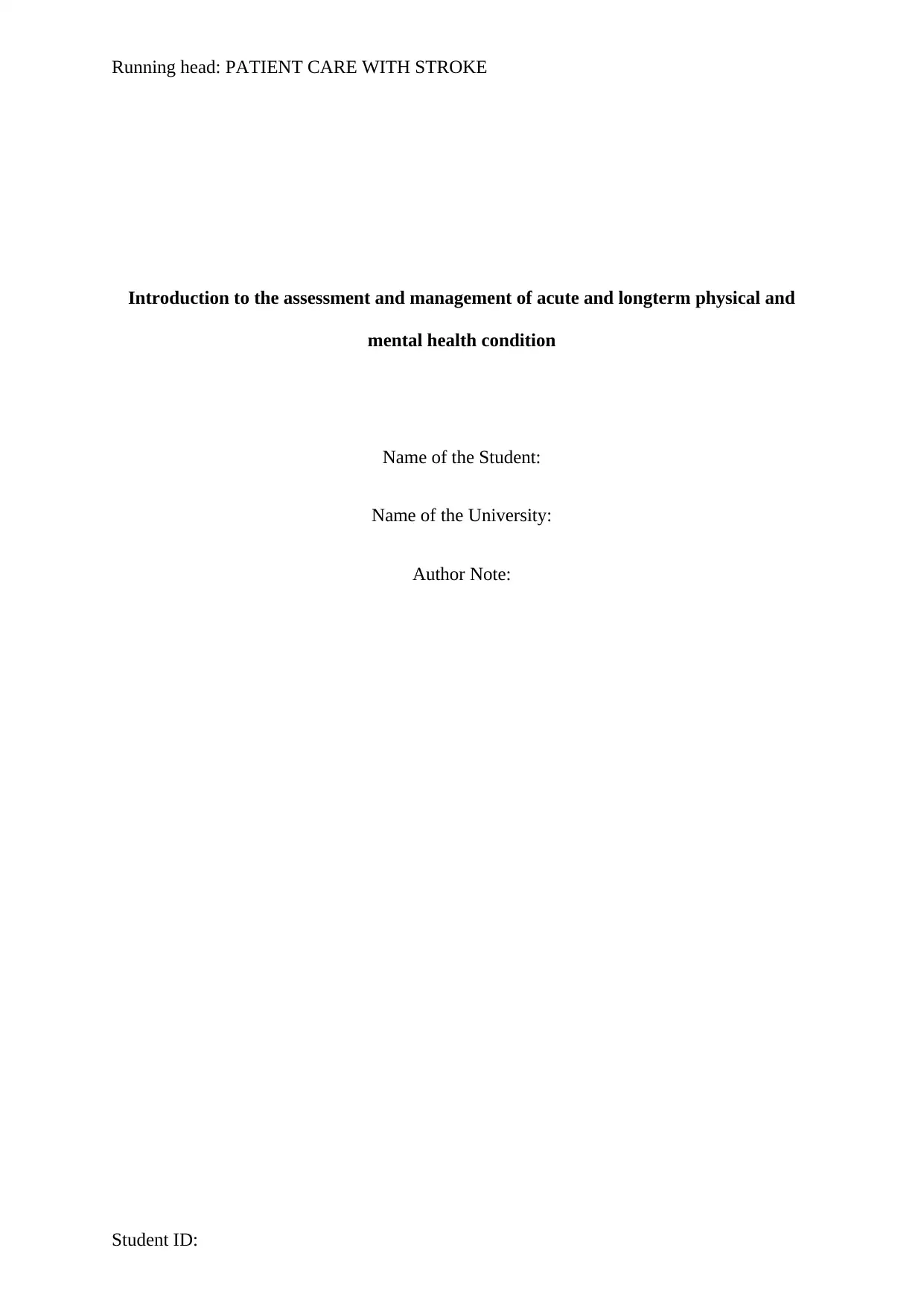
Running head: PATIENT CARE WITH STROKE
Introduction to the assessment and management of acute and longterm physical and
mental health condition
Name of the Student:
Name of the University:
Author Note:
Student ID:
Introduction to the assessment and management of acute and longterm physical and
mental health condition
Name of the Student:
Name of the University:
Author Note:
Student ID:
Secure Best Marks with AI Grader
Need help grading? Try our AI Grader for instant feedback on your assignments.
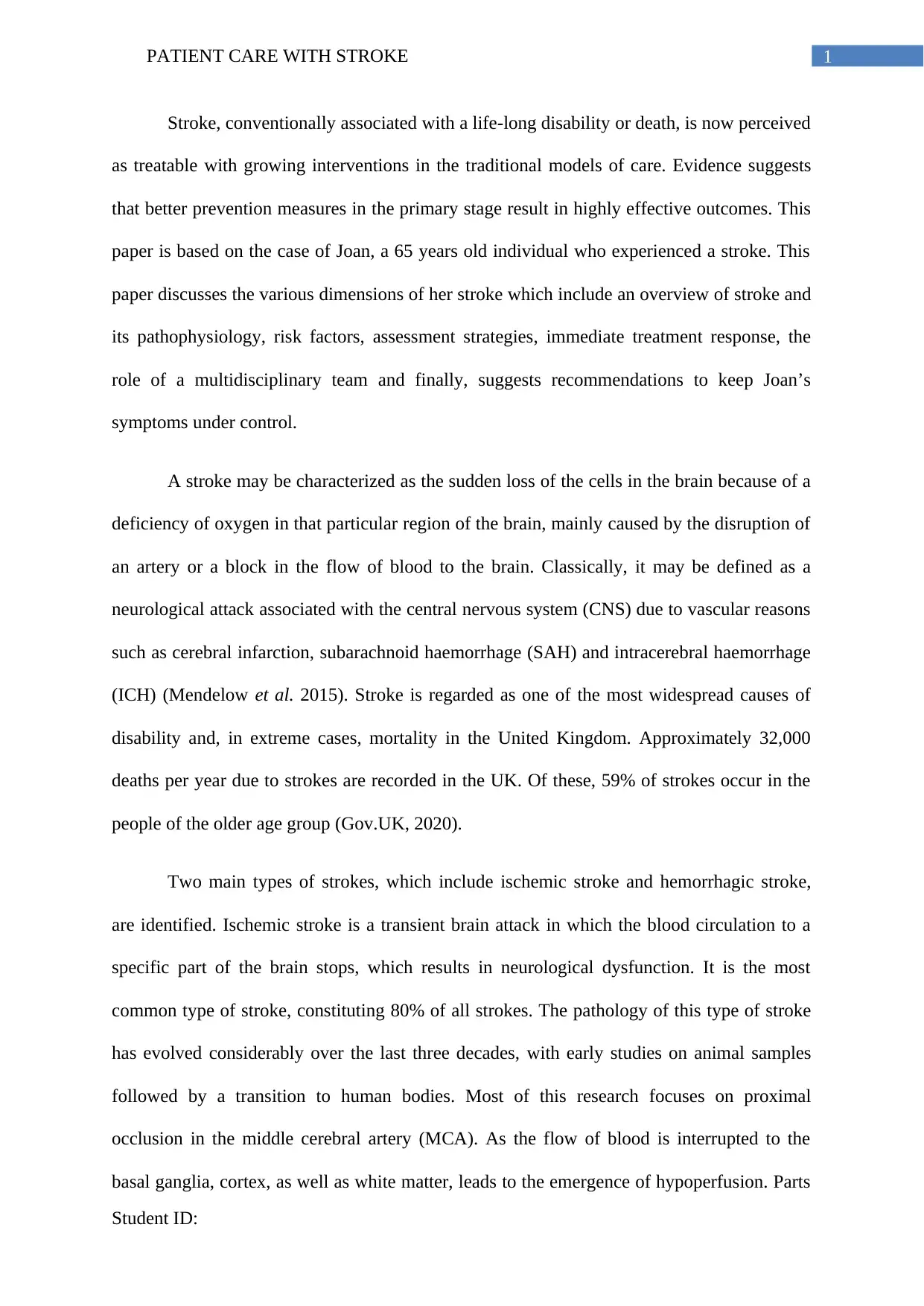
1PATIENT CARE WITH STROKE
Stroke, conventionally associated with a life-long disability or death, is now perceived
as treatable with growing interventions in the traditional models of care. Evidence suggests
that better prevention measures in the primary stage result in highly effective outcomes. This
paper is based on the case of Joan, a 65 years old individual who experienced a stroke. This
paper discusses the various dimensions of her stroke which include an overview of stroke and
its pathophysiology, risk factors, assessment strategies, immediate treatment response, the
role of a multidisciplinary team and finally, suggests recommendations to keep Joan’s
symptoms under control.
A stroke may be characterized as the sudden loss of the cells in the brain because of a
deficiency of oxygen in that particular region of the brain, mainly caused by the disruption of
an artery or a block in the flow of blood to the brain. Classically, it may be defined as a
neurological attack associated with the central nervous system (CNS) due to vascular reasons
such as cerebral infarction, subarachnoid haemorrhage (SAH) and intracerebral haemorrhage
(ICH) (Mendelow et al. 2015). Stroke is regarded as one of the most widespread causes of
disability and, in extreme cases, mortality in the United Kingdom. Approximately 32,000
deaths per year due to strokes are recorded in the UK. Of these, 59% of strokes occur in the
people of the older age group (Gov.UK, 2020).
Two main types of strokes, which include ischemic stroke and hemorrhagic stroke,
are identified. Ischemic stroke is a transient brain attack in which the blood circulation to a
specific part of the brain stops, which results in neurological dysfunction. It is the most
common type of stroke, constituting 80% of all strokes. The pathology of this type of stroke
has evolved considerably over the last three decades, with early studies on animal samples
followed by a transition to human bodies. Most of this research focuses on proximal
occlusion in the middle cerebral artery (MCA). As the flow of blood is interrupted to the
basal ganglia, cortex, as well as white matter, leads to the emergence of hypoperfusion. Parts
Student ID:
Stroke, conventionally associated with a life-long disability or death, is now perceived
as treatable with growing interventions in the traditional models of care. Evidence suggests
that better prevention measures in the primary stage result in highly effective outcomes. This
paper is based on the case of Joan, a 65 years old individual who experienced a stroke. This
paper discusses the various dimensions of her stroke which include an overview of stroke and
its pathophysiology, risk factors, assessment strategies, immediate treatment response, the
role of a multidisciplinary team and finally, suggests recommendations to keep Joan’s
symptoms under control.
A stroke may be characterized as the sudden loss of the cells in the brain because of a
deficiency of oxygen in that particular region of the brain, mainly caused by the disruption of
an artery or a block in the flow of blood to the brain. Classically, it may be defined as a
neurological attack associated with the central nervous system (CNS) due to vascular reasons
such as cerebral infarction, subarachnoid haemorrhage (SAH) and intracerebral haemorrhage
(ICH) (Mendelow et al. 2015). Stroke is regarded as one of the most widespread causes of
disability and, in extreme cases, mortality in the United Kingdom. Approximately 32,000
deaths per year due to strokes are recorded in the UK. Of these, 59% of strokes occur in the
people of the older age group (Gov.UK, 2020).
Two main types of strokes, which include ischemic stroke and hemorrhagic stroke,
are identified. Ischemic stroke is a transient brain attack in which the blood circulation to a
specific part of the brain stops, which results in neurological dysfunction. It is the most
common type of stroke, constituting 80% of all strokes. The pathology of this type of stroke
has evolved considerably over the last three decades, with early studies on animal samples
followed by a transition to human bodies. Most of this research focuses on proximal
occlusion in the middle cerebral artery (MCA). As the flow of blood is interrupted to the
basal ganglia, cortex, as well as white matter, leads to the emergence of hypoperfusion. Parts
Student ID:
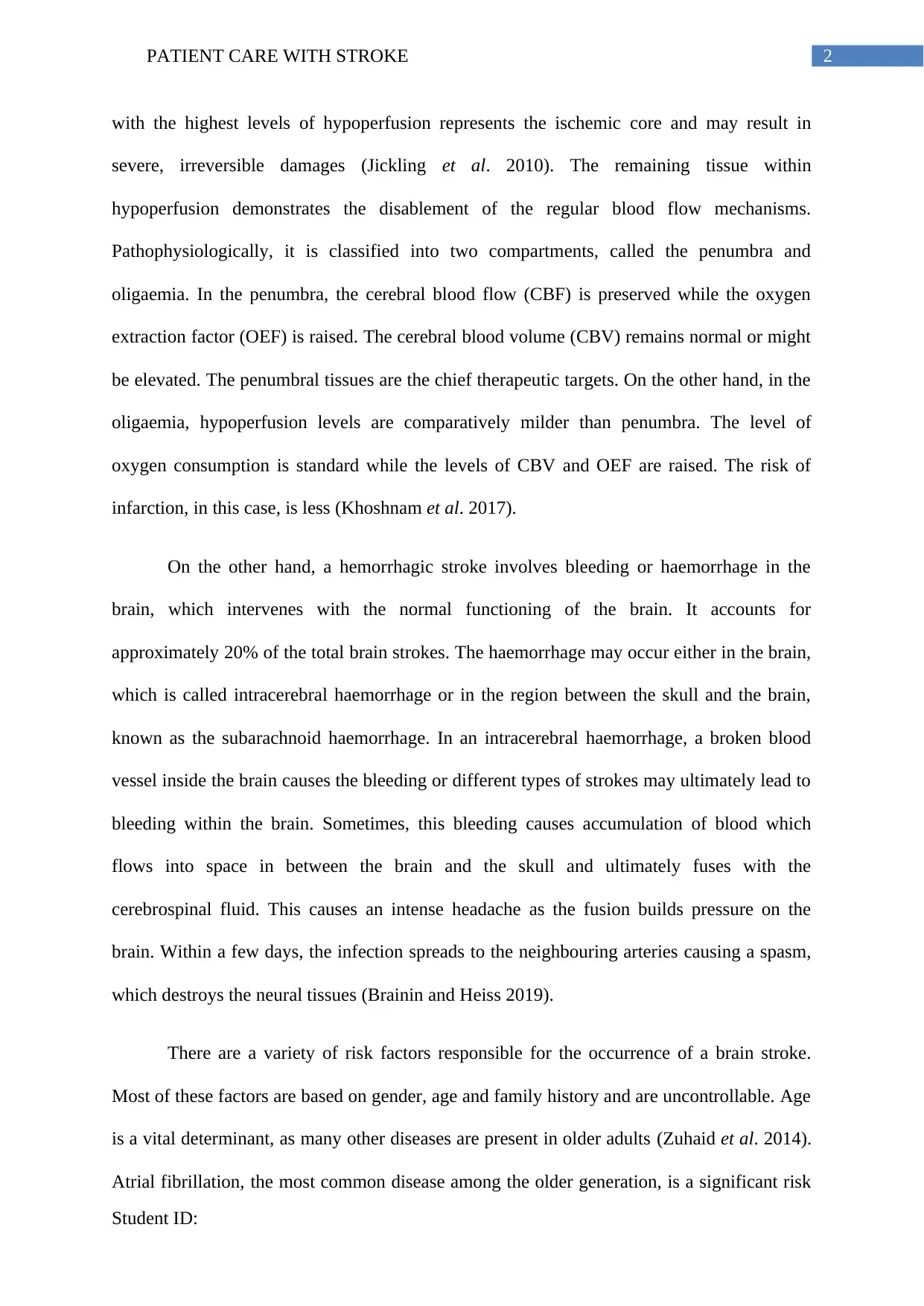
2PATIENT CARE WITH STROKE
with the highest levels of hypoperfusion represents the ischemic core and may result in
severe, irreversible damages (Jickling et al. 2010). The remaining tissue within
hypoperfusion demonstrates the disablement of the regular blood flow mechanisms.
Pathophysiologically, it is classified into two compartments, called the penumbra and
oligaemia. In the penumbra, the cerebral blood flow (CBF) is preserved while the oxygen
extraction factor (OEF) is raised. The cerebral blood volume (CBV) remains normal or might
be elevated. The penumbral tissues are the chief therapeutic targets. On the other hand, in the
oligaemia, hypoperfusion levels are comparatively milder than penumbra. The level of
oxygen consumption is standard while the levels of CBV and OEF are raised. The risk of
infarction, in this case, is less (Khoshnam et al. 2017).
On the other hand, a hemorrhagic stroke involves bleeding or haemorrhage in the
brain, which intervenes with the normal functioning of the brain. It accounts for
approximately 20% of the total brain strokes. The haemorrhage may occur either in the brain,
which is called intracerebral haemorrhage or in the region between the skull and the brain,
known as the subarachnoid haemorrhage. In an intracerebral haemorrhage, a broken blood
vessel inside the brain causes the bleeding or different types of strokes may ultimately lead to
bleeding within the brain. Sometimes, this bleeding causes accumulation of blood which
flows into space in between the brain and the skull and ultimately fuses with the
cerebrospinal fluid. This causes an intense headache as the fusion builds pressure on the
brain. Within a few days, the infection spreads to the neighbouring arteries causing a spasm,
which destroys the neural tissues (Brainin and Heiss 2019).
There are a variety of risk factors responsible for the occurrence of a brain stroke.
Most of these factors are based on gender, age and family history and are uncontrollable. Age
is a vital determinant, as many other diseases are present in older adults (Zuhaid et al. 2014).
Atrial fibrillation, the most common disease among the older generation, is a significant risk
Student ID:
with the highest levels of hypoperfusion represents the ischemic core and may result in
severe, irreversible damages (Jickling et al. 2010). The remaining tissue within
hypoperfusion demonstrates the disablement of the regular blood flow mechanisms.
Pathophysiologically, it is classified into two compartments, called the penumbra and
oligaemia. In the penumbra, the cerebral blood flow (CBF) is preserved while the oxygen
extraction factor (OEF) is raised. The cerebral blood volume (CBV) remains normal or might
be elevated. The penumbral tissues are the chief therapeutic targets. On the other hand, in the
oligaemia, hypoperfusion levels are comparatively milder than penumbra. The level of
oxygen consumption is standard while the levels of CBV and OEF are raised. The risk of
infarction, in this case, is less (Khoshnam et al. 2017).
On the other hand, a hemorrhagic stroke involves bleeding or haemorrhage in the
brain, which intervenes with the normal functioning of the brain. It accounts for
approximately 20% of the total brain strokes. The haemorrhage may occur either in the brain,
which is called intracerebral haemorrhage or in the region between the skull and the brain,
known as the subarachnoid haemorrhage. In an intracerebral haemorrhage, a broken blood
vessel inside the brain causes the bleeding or different types of strokes may ultimately lead to
bleeding within the brain. Sometimes, this bleeding causes accumulation of blood which
flows into space in between the brain and the skull and ultimately fuses with the
cerebrospinal fluid. This causes an intense headache as the fusion builds pressure on the
brain. Within a few days, the infection spreads to the neighbouring arteries causing a spasm,
which destroys the neural tissues (Brainin and Heiss 2019).
There are a variety of risk factors responsible for the occurrence of a brain stroke.
Most of these factors are based on gender, age and family history and are uncontrollable. Age
is a vital determinant, as many other diseases are present in older adults (Zuhaid et al. 2014).
Atrial fibrillation, the most common disease among the older generation, is a significant risk
Student ID:
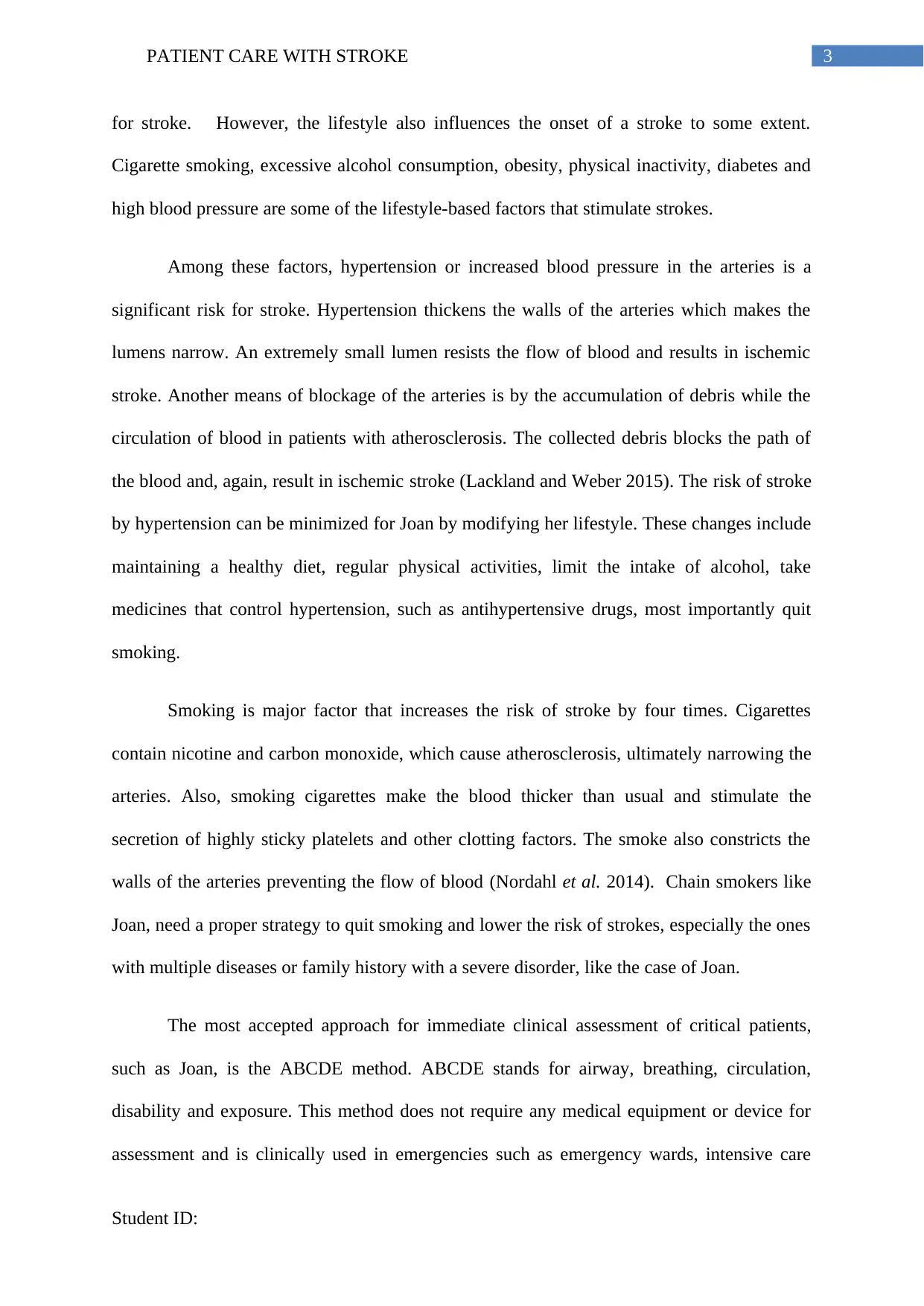
3PATIENT CARE WITH STROKE
for stroke. However, the lifestyle also influences the onset of a stroke to some extent.
Cigarette smoking, excessive alcohol consumption, obesity, physical inactivity, diabetes and
high blood pressure are some of the lifestyle-based factors that stimulate strokes.
Among these factors, hypertension or increased blood pressure in the arteries is a
significant risk for stroke. Hypertension thickens the walls of the arteries which makes the
lumens narrow. An extremely small lumen resists the flow of blood and results in ischemic
stroke. Another means of blockage of the arteries is by the accumulation of debris while the
circulation of blood in patients with atherosclerosis. The collected debris blocks the path of
the blood and, again, result in ischemic stroke (Lackland and Weber 2015). The risk of stroke
by hypertension can be minimized for Joan by modifying her lifestyle. These changes include
maintaining a healthy diet, regular physical activities, limit the intake of alcohol, take
medicines that control hypertension, such as antihypertensive drugs, most importantly quit
smoking.
Smoking is major factor that increases the risk of stroke by four times. Cigarettes
contain nicotine and carbon monoxide, which cause atherosclerosis, ultimately narrowing the
arteries. Also, smoking cigarettes make the blood thicker than usual and stimulate the
secretion of highly sticky platelets and other clotting factors. The smoke also constricts the
walls of the arteries preventing the flow of blood (Nordahl et al. 2014). Chain smokers like
Joan, need a proper strategy to quit smoking and lower the risk of strokes, especially the ones
with multiple diseases or family history with a severe disorder, like the case of Joan.
The most accepted approach for immediate clinical assessment of critical patients,
such as Joan, is the ABCDE method. ABCDE stands for airway, breathing, circulation,
disability and exposure. This method does not require any medical equipment or device for
assessment and is clinically used in emergencies such as emergency wards, intensive care
Student ID:
for stroke. However, the lifestyle also influences the onset of a stroke to some extent.
Cigarette smoking, excessive alcohol consumption, obesity, physical inactivity, diabetes and
high blood pressure are some of the lifestyle-based factors that stimulate strokes.
Among these factors, hypertension or increased blood pressure in the arteries is a
significant risk for stroke. Hypertension thickens the walls of the arteries which makes the
lumens narrow. An extremely small lumen resists the flow of blood and results in ischemic
stroke. Another means of blockage of the arteries is by the accumulation of debris while the
circulation of blood in patients with atherosclerosis. The collected debris blocks the path of
the blood and, again, result in ischemic stroke (Lackland and Weber 2015). The risk of stroke
by hypertension can be minimized for Joan by modifying her lifestyle. These changes include
maintaining a healthy diet, regular physical activities, limit the intake of alcohol, take
medicines that control hypertension, such as antihypertensive drugs, most importantly quit
smoking.
Smoking is major factor that increases the risk of stroke by four times. Cigarettes
contain nicotine and carbon monoxide, which cause atherosclerosis, ultimately narrowing the
arteries. Also, smoking cigarettes make the blood thicker than usual and stimulate the
secretion of highly sticky platelets and other clotting factors. The smoke also constricts the
walls of the arteries preventing the flow of blood (Nordahl et al. 2014). Chain smokers like
Joan, need a proper strategy to quit smoking and lower the risk of strokes, especially the ones
with multiple diseases or family history with a severe disorder, like the case of Joan.
The most accepted approach for immediate clinical assessment of critical patients,
such as Joan, is the ABCDE method. ABCDE stands for airway, breathing, circulation,
disability and exposure. This method does not require any medical equipment or device for
assessment and is clinically used in emergencies such as emergency wards, intensive care
Student ID:
Secure Best Marks with AI Grader
Need help grading? Try our AI Grader for instant feedback on your assignments.
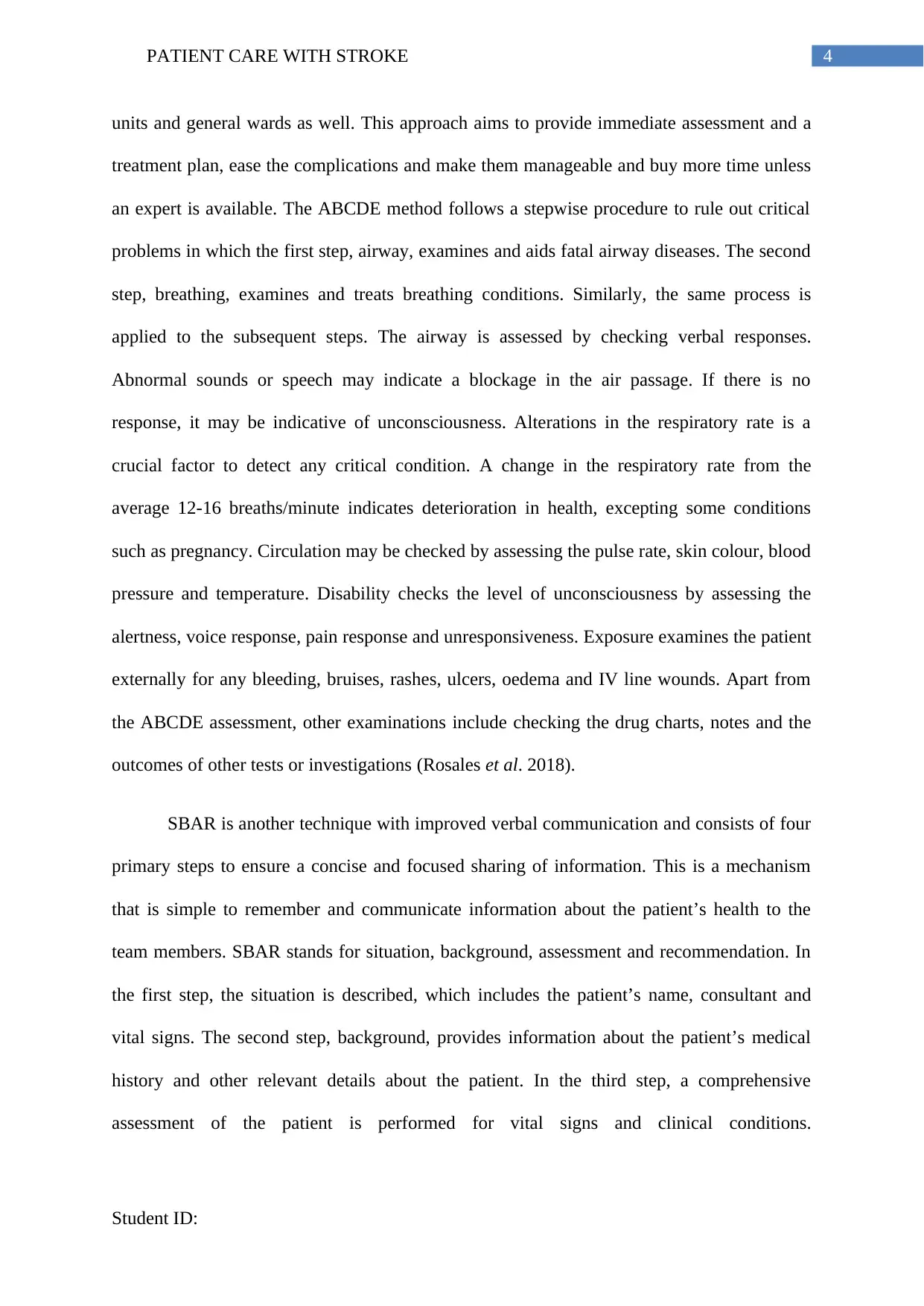
4PATIENT CARE WITH STROKE
units and general wards as well. This approach aims to provide immediate assessment and a
treatment plan, ease the complications and make them manageable and buy more time unless
an expert is available. The ABCDE method follows a stepwise procedure to rule out critical
problems in which the first step, airway, examines and aids fatal airway diseases. The second
step, breathing, examines and treats breathing conditions. Similarly, the same process is
applied to the subsequent steps. The airway is assessed by checking verbal responses.
Abnormal sounds or speech may indicate a blockage in the air passage. If there is no
response, it may be indicative of unconsciousness. Alterations in the respiratory rate is a
crucial factor to detect any critical condition. A change in the respiratory rate from the
average 12-16 breaths/minute indicates deterioration in health, excepting some conditions
such as pregnancy. Circulation may be checked by assessing the pulse rate, skin colour, blood
pressure and temperature. Disability checks the level of unconsciousness by assessing the
alertness, voice response, pain response and unresponsiveness. Exposure examines the patient
externally for any bleeding, bruises, rashes, ulcers, oedema and IV line wounds. Apart from
the ABCDE assessment, other examinations include checking the drug charts, notes and the
outcomes of other tests or investigations (Rosales et al. 2018).
SBAR is another technique with improved verbal communication and consists of four
primary steps to ensure a concise and focused sharing of information. This is a mechanism
that is simple to remember and communicate information about the patient’s health to the
team members. SBAR stands for situation, background, assessment and recommendation. In
the first step, the situation is described, which includes the patient’s name, consultant and
vital signs. The second step, background, provides information about the patient’s medical
history and other relevant details about the patient. In the third step, a comprehensive
assessment of the patient is performed for vital signs and clinical conditions.
Student ID:
units and general wards as well. This approach aims to provide immediate assessment and a
treatment plan, ease the complications and make them manageable and buy more time unless
an expert is available. The ABCDE method follows a stepwise procedure to rule out critical
problems in which the first step, airway, examines and aids fatal airway diseases. The second
step, breathing, examines and treats breathing conditions. Similarly, the same process is
applied to the subsequent steps. The airway is assessed by checking verbal responses.
Abnormal sounds or speech may indicate a blockage in the air passage. If there is no
response, it may be indicative of unconsciousness. Alterations in the respiratory rate is a
crucial factor to detect any critical condition. A change in the respiratory rate from the
average 12-16 breaths/minute indicates deterioration in health, excepting some conditions
such as pregnancy. Circulation may be checked by assessing the pulse rate, skin colour, blood
pressure and temperature. Disability checks the level of unconsciousness by assessing the
alertness, voice response, pain response and unresponsiveness. Exposure examines the patient
externally for any bleeding, bruises, rashes, ulcers, oedema and IV line wounds. Apart from
the ABCDE assessment, other examinations include checking the drug charts, notes and the
outcomes of other tests or investigations (Rosales et al. 2018).
SBAR is another technique with improved verbal communication and consists of four
primary steps to ensure a concise and focused sharing of information. This is a mechanism
that is simple to remember and communicate information about the patient’s health to the
team members. SBAR stands for situation, background, assessment and recommendation. In
the first step, the situation is described, which includes the patient’s name, consultant and
vital signs. The second step, background, provides information about the patient’s medical
history and other relevant details about the patient. In the third step, a comprehensive
assessment of the patient is performed for vital signs and clinical conditions.
Student ID:
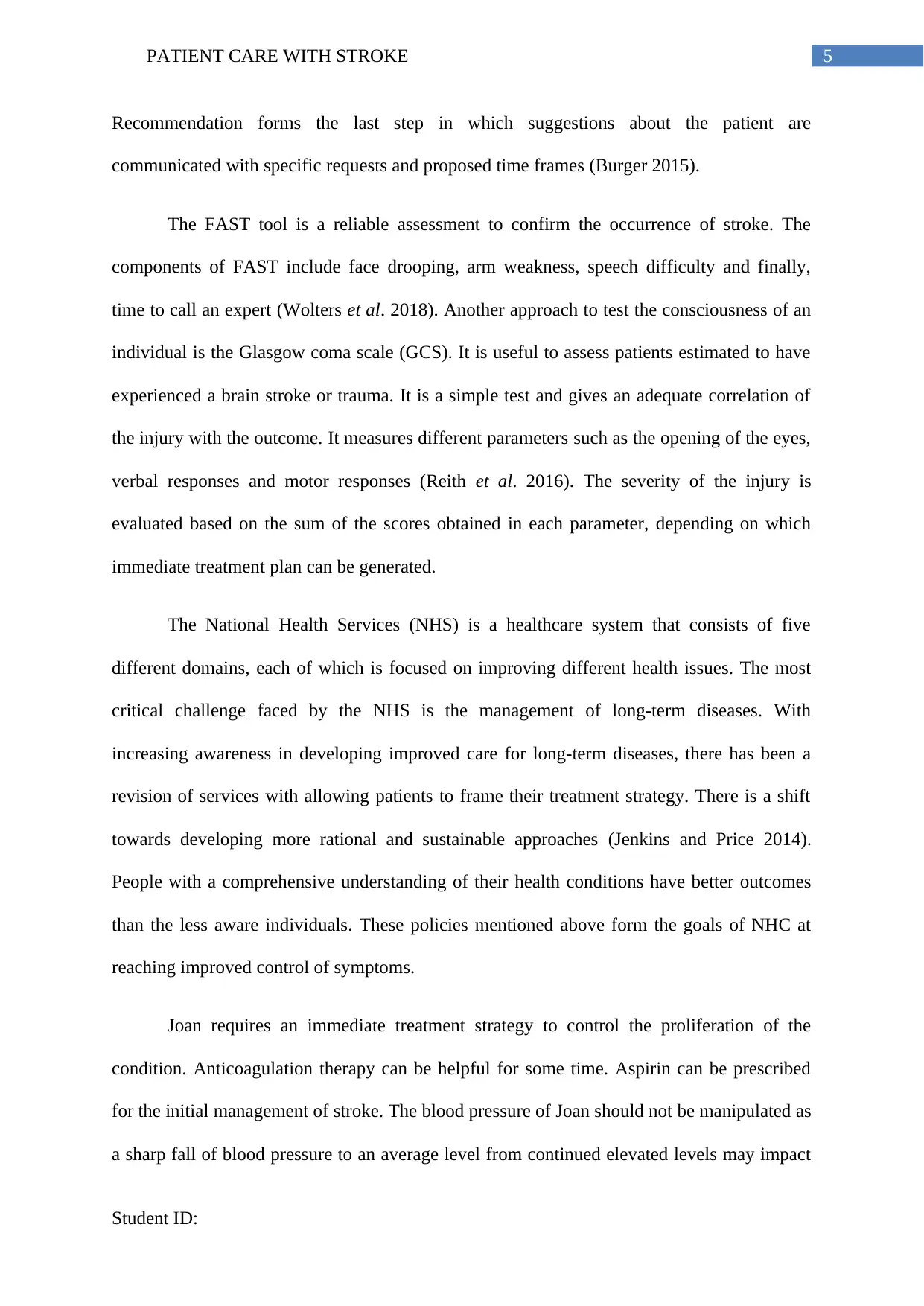
5PATIENT CARE WITH STROKE
Recommendation forms the last step in which suggestions about the patient are
communicated with specific requests and proposed time frames (Burger 2015).
The FAST tool is a reliable assessment to confirm the occurrence of stroke. The
components of FAST include face drooping, arm weakness, speech difficulty and finally,
time to call an expert (Wolters et al. 2018). Another approach to test the consciousness of an
individual is the Glasgow coma scale (GCS). It is useful to assess patients estimated to have
experienced a brain stroke or trauma. It is a simple test and gives an adequate correlation of
the injury with the outcome. It measures different parameters such as the opening of the eyes,
verbal responses and motor responses (Reith et al. 2016). The severity of the injury is
evaluated based on the sum of the scores obtained in each parameter, depending on which
immediate treatment plan can be generated.
The National Health Services (NHS) is a healthcare system that consists of five
different domains, each of which is focused on improving different health issues. The most
critical challenge faced by the NHS is the management of long-term diseases. With
increasing awareness in developing improved care for long-term diseases, there has been a
revision of services with allowing patients to frame their treatment strategy. There is a shift
towards developing more rational and sustainable approaches (Jenkins and Price 2014).
People with a comprehensive understanding of their health conditions have better outcomes
than the less aware individuals. These policies mentioned above form the goals of NHC at
reaching improved control of symptoms.
Joan requires an immediate treatment strategy to control the proliferation of the
condition. Anticoagulation therapy can be helpful for some time. Aspirin can be prescribed
for the initial management of stroke. The blood pressure of Joan should not be manipulated as
a sharp fall of blood pressure to an average level from continued elevated levels may impact
Student ID:
Recommendation forms the last step in which suggestions about the patient are
communicated with specific requests and proposed time frames (Burger 2015).
The FAST tool is a reliable assessment to confirm the occurrence of stroke. The
components of FAST include face drooping, arm weakness, speech difficulty and finally,
time to call an expert (Wolters et al. 2018). Another approach to test the consciousness of an
individual is the Glasgow coma scale (GCS). It is useful to assess patients estimated to have
experienced a brain stroke or trauma. It is a simple test and gives an adequate correlation of
the injury with the outcome. It measures different parameters such as the opening of the eyes,
verbal responses and motor responses (Reith et al. 2016). The severity of the injury is
evaluated based on the sum of the scores obtained in each parameter, depending on which
immediate treatment plan can be generated.
The National Health Services (NHS) is a healthcare system that consists of five
different domains, each of which is focused on improving different health issues. The most
critical challenge faced by the NHS is the management of long-term diseases. With
increasing awareness in developing improved care for long-term diseases, there has been a
revision of services with allowing patients to frame their treatment strategy. There is a shift
towards developing more rational and sustainable approaches (Jenkins and Price 2014).
People with a comprehensive understanding of their health conditions have better outcomes
than the less aware individuals. These policies mentioned above form the goals of NHC at
reaching improved control of symptoms.
Joan requires an immediate treatment strategy to control the proliferation of the
condition. Anticoagulation therapy can be helpful for some time. Aspirin can be prescribed
for the initial management of stroke. The blood pressure of Joan should not be manipulated as
a sharp fall of blood pressure to an average level from continued elevated levels may impact
Student ID:
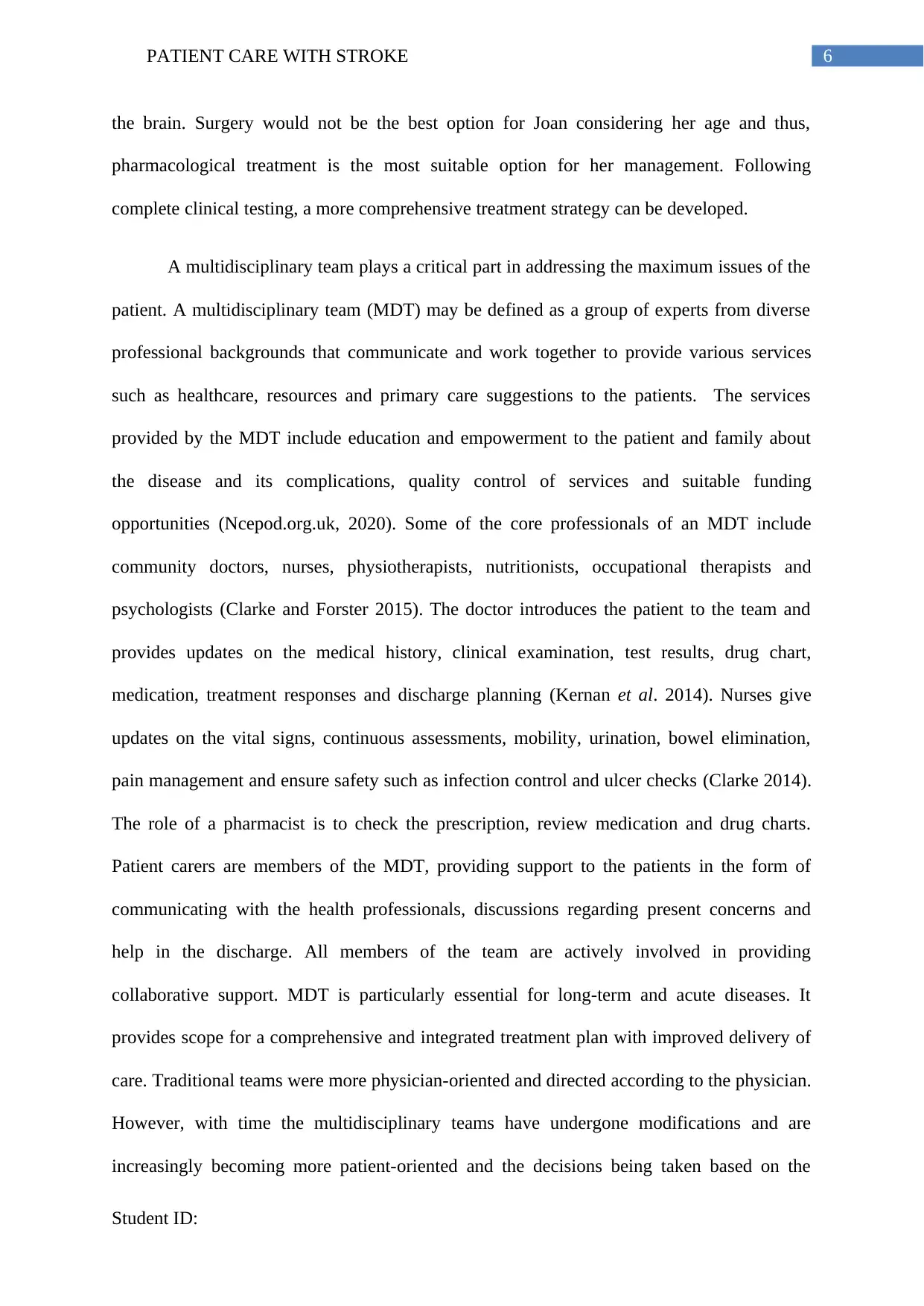
6PATIENT CARE WITH STROKE
the brain. Surgery would not be the best option for Joan considering her age and thus,
pharmacological treatment is the most suitable option for her management. Following
complete clinical testing, a more comprehensive treatment strategy can be developed.
A multidisciplinary team plays a critical part in addressing the maximum issues of the
patient. A multidisciplinary team (MDT) may be defined as a group of experts from diverse
professional backgrounds that communicate and work together to provide various services
such as healthcare, resources and primary care suggestions to the patients. The services
provided by the MDT include education and empowerment to the patient and family about
the disease and its complications, quality control of services and suitable funding
opportunities (Ncepod.org.uk, 2020). Some of the core professionals of an MDT include
community doctors, nurses, physiotherapists, nutritionists, occupational therapists and
psychologists (Clarke and Forster 2015). The doctor introduces the patient to the team and
provides updates on the medical history, clinical examination, test results, drug chart,
medication, treatment responses and discharge planning (Kernan et al. 2014). Nurses give
updates on the vital signs, continuous assessments, mobility, urination, bowel elimination,
pain management and ensure safety such as infection control and ulcer checks (Clarke 2014).
The role of a pharmacist is to check the prescription, review medication and drug charts.
Patient carers are members of the MDT, providing support to the patients in the form of
communicating with the health professionals, discussions regarding present concerns and
help in the discharge. All members of the team are actively involved in providing
collaborative support. MDT is particularly essential for long-term and acute diseases. It
provides scope for a comprehensive and integrated treatment plan with improved delivery of
care. Traditional teams were more physician-oriented and directed according to the physician.
However, with time the multidisciplinary teams have undergone modifications and are
increasingly becoming more patient-oriented and the decisions being taken based on the
Student ID:
the brain. Surgery would not be the best option for Joan considering her age and thus,
pharmacological treatment is the most suitable option for her management. Following
complete clinical testing, a more comprehensive treatment strategy can be developed.
A multidisciplinary team plays a critical part in addressing the maximum issues of the
patient. A multidisciplinary team (MDT) may be defined as a group of experts from diverse
professional backgrounds that communicate and work together to provide various services
such as healthcare, resources and primary care suggestions to the patients. The services
provided by the MDT include education and empowerment to the patient and family about
the disease and its complications, quality control of services and suitable funding
opportunities (Ncepod.org.uk, 2020). Some of the core professionals of an MDT include
community doctors, nurses, physiotherapists, nutritionists, occupational therapists and
psychologists (Clarke and Forster 2015). The doctor introduces the patient to the team and
provides updates on the medical history, clinical examination, test results, drug chart,
medication, treatment responses and discharge planning (Kernan et al. 2014). Nurses give
updates on the vital signs, continuous assessments, mobility, urination, bowel elimination,
pain management and ensure safety such as infection control and ulcer checks (Clarke 2014).
The role of a pharmacist is to check the prescription, review medication and drug charts.
Patient carers are members of the MDT, providing support to the patients in the form of
communicating with the health professionals, discussions regarding present concerns and
help in the discharge. All members of the team are actively involved in providing
collaborative support. MDT is particularly essential for long-term and acute diseases. It
provides scope for a comprehensive and integrated treatment plan with improved delivery of
care. Traditional teams were more physician-oriented and directed according to the physician.
However, with time the multidisciplinary teams have undergone modifications and are
increasingly becoming more patient-oriented and the decisions being taken based on the
Student ID:
Paraphrase This Document
Need a fresh take? Get an instant paraphrase of this document with our AI Paraphraser

7PATIENT CARE WITH STROKE
needs and opinions of the patients. Ultimately, the success of the team depends on the
decisions and approaches applied by the team in the treatment plan.
Thus, in conclusion, Joan seems to have experienced an ischemic stroke and needs an
immediate treatment strategy to prevent the condition from worsening. On confirmation of
stroke by the paramedics, Joan must be taken to a neurologist or neurosurgeon for
consultation on decisions such as clot retrieval or tPA treatment (Boehme et al. 2014).
Immediate action is of utmost importance as longer the stroke remains untreated, more severe
the condition becomes a higher number of irreplaceable brain cells are dead. The critical care
experts then reach out to the patients for stabilization post tPA. Rehabilitation physicians or
occupational therapists may be appointed to help Joan cope with the situation and quit
smoking.
Student ID:
needs and opinions of the patients. Ultimately, the success of the team depends on the
decisions and approaches applied by the team in the treatment plan.
Thus, in conclusion, Joan seems to have experienced an ischemic stroke and needs an
immediate treatment strategy to prevent the condition from worsening. On confirmation of
stroke by the paramedics, Joan must be taken to a neurologist or neurosurgeon for
consultation on decisions such as clot retrieval or tPA treatment (Boehme et al. 2014).
Immediate action is of utmost importance as longer the stroke remains untreated, more severe
the condition becomes a higher number of irreplaceable brain cells are dead. The critical care
experts then reach out to the patients for stabilization post tPA. Rehabilitation physicians or
occupational therapists may be appointed to help Joan cope with the situation and quit
smoking.
Student ID:
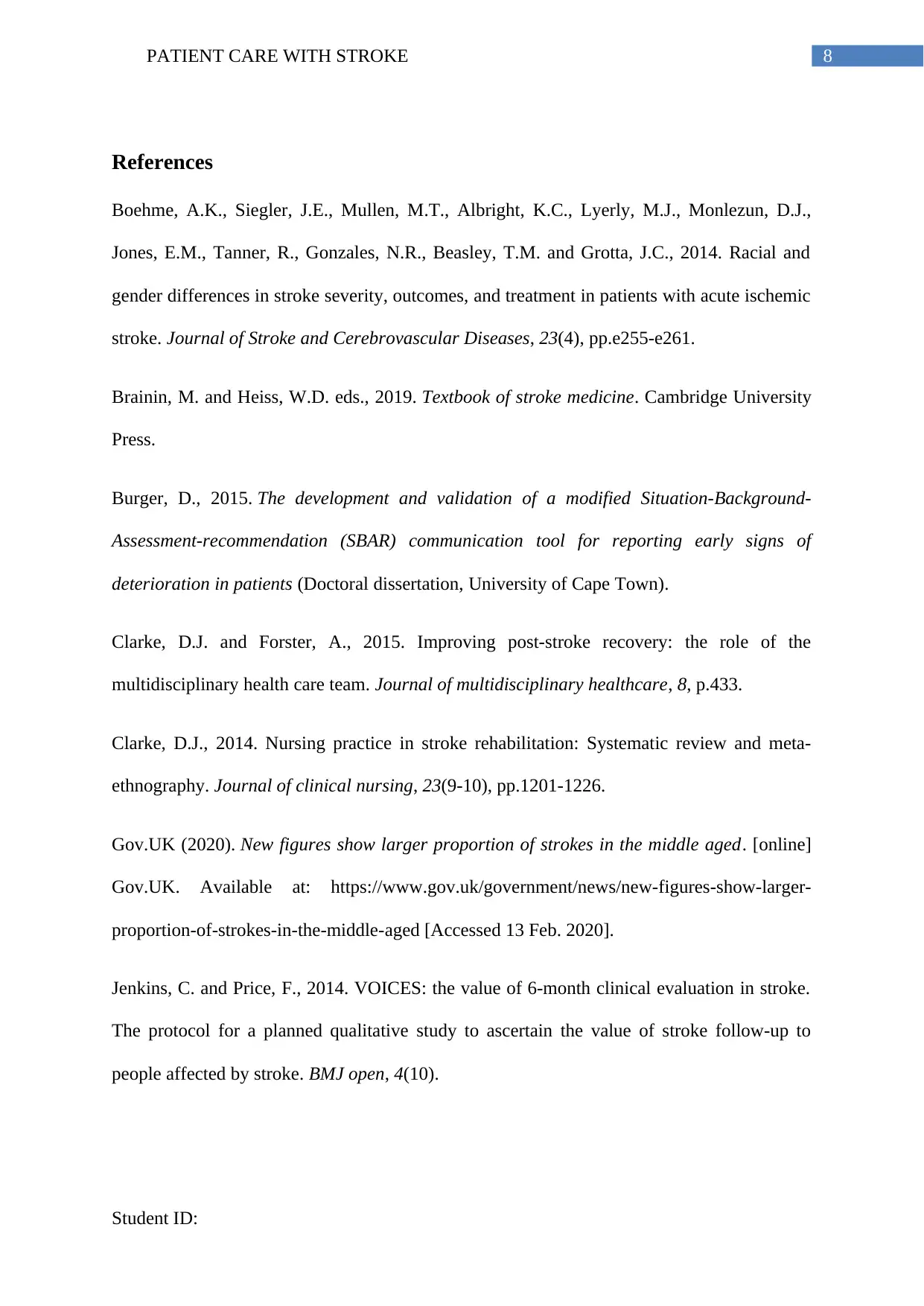
8PATIENT CARE WITH STROKE
References
Boehme, A.K., Siegler, J.E., Mullen, M.T., Albright, K.C., Lyerly, M.J., Monlezun, D.J.,
Jones, E.M., Tanner, R., Gonzales, N.R., Beasley, T.M. and Grotta, J.C., 2014. Racial and
gender differences in stroke severity, outcomes, and treatment in patients with acute ischemic
stroke. Journal of Stroke and Cerebrovascular Diseases, 23(4), pp.e255-e261.
Brainin, M. and Heiss, W.D. eds., 2019. Textbook of stroke medicine. Cambridge University
Press.
Burger, D., 2015. The development and validation of a modified Situation-Background-
Assessment-recommendation (SBAR) communication tool for reporting early signs of
deterioration in patients (Doctoral dissertation, University of Cape Town).
Clarke, D.J. and Forster, A., 2015. Improving post-stroke recovery: the role of the
multidisciplinary health care team. Journal of multidisciplinary healthcare, 8, p.433.
Clarke, D.J., 2014. Nursing practice in stroke rehabilitation: Systematic review and meta‐
ethnography. Journal of clinical nursing, 23(9-10), pp.1201-1226.
Gov.UK (2020). New figures show larger proportion of strokes in the middle aged. [online]
Gov.UK. Available at: https://www.gov.uk/government/news/new-figures-show-larger-
proportion-of-strokes-in-the-middle-aged [Accessed 13 Feb. 2020].
Jenkins, C. and Price, F., 2014. VOICES: the value of 6-month clinical evaluation in stroke.
The protocol for a planned qualitative study to ascertain the value of stroke follow-up to
people affected by stroke. BMJ open, 4(10).
Student ID:
References
Boehme, A.K., Siegler, J.E., Mullen, M.T., Albright, K.C., Lyerly, M.J., Monlezun, D.J.,
Jones, E.M., Tanner, R., Gonzales, N.R., Beasley, T.M. and Grotta, J.C., 2014. Racial and
gender differences in stroke severity, outcomes, and treatment in patients with acute ischemic
stroke. Journal of Stroke and Cerebrovascular Diseases, 23(4), pp.e255-e261.
Brainin, M. and Heiss, W.D. eds., 2019. Textbook of stroke medicine. Cambridge University
Press.
Burger, D., 2015. The development and validation of a modified Situation-Background-
Assessment-recommendation (SBAR) communication tool for reporting early signs of
deterioration in patients (Doctoral dissertation, University of Cape Town).
Clarke, D.J. and Forster, A., 2015. Improving post-stroke recovery: the role of the
multidisciplinary health care team. Journal of multidisciplinary healthcare, 8, p.433.
Clarke, D.J., 2014. Nursing practice in stroke rehabilitation: Systematic review and meta‐
ethnography. Journal of clinical nursing, 23(9-10), pp.1201-1226.
Gov.UK (2020). New figures show larger proportion of strokes in the middle aged. [online]
Gov.UK. Available at: https://www.gov.uk/government/news/new-figures-show-larger-
proportion-of-strokes-in-the-middle-aged [Accessed 13 Feb. 2020].
Jenkins, C. and Price, F., 2014. VOICES: the value of 6-month clinical evaluation in stroke.
The protocol for a planned qualitative study to ascertain the value of stroke follow-up to
people affected by stroke. BMJ open, 4(10).
Student ID:

9PATIENT CARE WITH STROKE
Jickling, G.C., Xu, H., Stamova, B., Ander, B.P., Zhan, X., Tian, Y., Liu, D., Turner, R.J.,
Mesias, M., Verro, P. and Khoury, J., 2010. Signatures of cardioembolic and large‐vessel
ischemic stroke. Annals of neurology, 68(5), pp.681-692.
Kernan, W.N., Ovbiagele, B., Black, H.R., Bravata, D.M., Chimowitz, M.I., Ezekowitz,
M.D., Fang, M.C., Fisher, M., Furie, K.L., Heck, D.V. and Johnston, S.C., 2014. Guidelines
for the prevention of stroke in patients with stroke and transient ischemic attack: a guideline
for healthcare professionals from the American Heart Association/American Stroke
Association. Stroke, 45(7), pp.2160-2236.
Khoshnam, S.E., Winlow, W., Farzaneh, M., Farbood, Y. and Moghaddam, H.F., 2017.
Pathogenic mechanisms following ischemic stroke. Neurological Sciences, 38(7), pp.1167-
1186.
Lackland, D.T. and Weber, M.A., 2015. Global burden of cardiovascular disease and stroke:
hypertension at the core. Canadian Journal of Cardiology, 31(5), pp.569-571.
Mendelow, A.D., Lo, E.H., Sacco, R.L., FAAN, M.M.F. and Wong, L.K., 2015. Stroke:
pathophysiology, diagnosis, and management. Elsevier Health Sciences.
Ncepod.org.uk. (2020). Retrieved 18 February 2020, from
http://www.ncepod.org.uk/2012report1/downloads/CAP_fullreport.pdf
Nordahl, H., Osler, M., Frederiksen, B.L., Andersen, I., Prescott, E., Overvad, K.,
Diderichsen, F. and Rod, N.H., 2014. Combined effects of socioeconomic position, smoking,
and hypertension on risk of ischemic and hemorrhagic stroke. Stroke, 45(9), pp.2582-2587.
Reith, F.C., Van den Brande, R., Synnot, A., Gruen, R. and Maas, A.I., 2016. The reliability
of the Glasgow Coma Scale: a systematic review. Intensive care medicine, 42(1), pp.3-15.
Student ID:
Jickling, G.C., Xu, H., Stamova, B., Ander, B.P., Zhan, X., Tian, Y., Liu, D., Turner, R.J.,
Mesias, M., Verro, P. and Khoury, J., 2010. Signatures of cardioembolic and large‐vessel
ischemic stroke. Annals of neurology, 68(5), pp.681-692.
Kernan, W.N., Ovbiagele, B., Black, H.R., Bravata, D.M., Chimowitz, M.I., Ezekowitz,
M.D., Fang, M.C., Fisher, M., Furie, K.L., Heck, D.V. and Johnston, S.C., 2014. Guidelines
for the prevention of stroke in patients with stroke and transient ischemic attack: a guideline
for healthcare professionals from the American Heart Association/American Stroke
Association. Stroke, 45(7), pp.2160-2236.
Khoshnam, S.E., Winlow, W., Farzaneh, M., Farbood, Y. and Moghaddam, H.F., 2017.
Pathogenic mechanisms following ischemic stroke. Neurological Sciences, 38(7), pp.1167-
1186.
Lackland, D.T. and Weber, M.A., 2015. Global burden of cardiovascular disease and stroke:
hypertension at the core. Canadian Journal of Cardiology, 31(5), pp.569-571.
Mendelow, A.D., Lo, E.H., Sacco, R.L., FAAN, M.M.F. and Wong, L.K., 2015. Stroke:
pathophysiology, diagnosis, and management. Elsevier Health Sciences.
Ncepod.org.uk. (2020). Retrieved 18 February 2020, from
http://www.ncepod.org.uk/2012report1/downloads/CAP_fullreport.pdf
Nordahl, H., Osler, M., Frederiksen, B.L., Andersen, I., Prescott, E., Overvad, K.,
Diderichsen, F. and Rod, N.H., 2014. Combined effects of socioeconomic position, smoking,
and hypertension on risk of ischemic and hemorrhagic stroke. Stroke, 45(9), pp.2582-2587.
Reith, F.C., Van den Brande, R., Synnot, A., Gruen, R. and Maas, A.I., 2016. The reliability
of the Glasgow Coma Scale: a systematic review. Intensive care medicine, 42(1), pp.3-15.
Student ID:
Secure Best Marks with AI Grader
Need help grading? Try our AI Grader for instant feedback on your assignments.
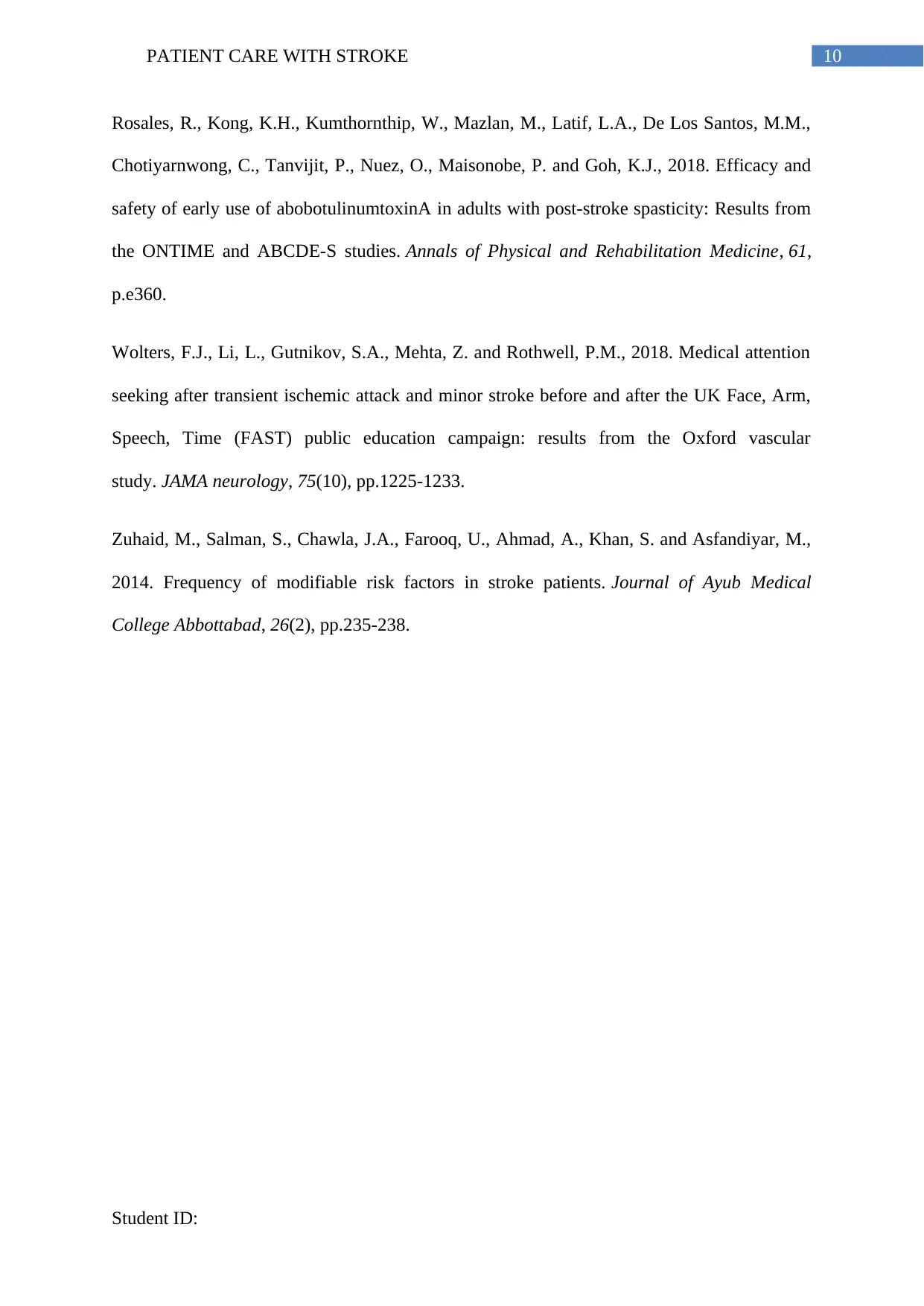
10PATIENT CARE WITH STROKE
Rosales, R., Kong, K.H., Kumthornthip, W., Mazlan, M., Latif, L.A., De Los Santos, M.M.,
Chotiyarnwong, C., Tanvijit, P., Nuez, O., Maisonobe, P. and Goh, K.J., 2018. Efficacy and
safety of early use of abobotulinumtoxinA in adults with post-stroke spasticity: Results from
the ONTIME and ABCDE-S studies. Annals of Physical and Rehabilitation Medicine, 61,
p.e360.
Wolters, F.J., Li, L., Gutnikov, S.A., Mehta, Z. and Rothwell, P.M., 2018. Medical attention
seeking after transient ischemic attack and minor stroke before and after the UK Face, Arm,
Speech, Time (FAST) public education campaign: results from the Oxford vascular
study. JAMA neurology, 75(10), pp.1225-1233.
Zuhaid, M., Salman, S., Chawla, J.A., Farooq, U., Ahmad, A., Khan, S. and Asfandiyar, M.,
2014. Frequency of modifiable risk factors in stroke patients. Journal of Ayub Medical
College Abbottabad, 26(2), pp.235-238.
Student ID:
Rosales, R., Kong, K.H., Kumthornthip, W., Mazlan, M., Latif, L.A., De Los Santos, M.M.,
Chotiyarnwong, C., Tanvijit, P., Nuez, O., Maisonobe, P. and Goh, K.J., 2018. Efficacy and
safety of early use of abobotulinumtoxinA in adults with post-stroke spasticity: Results from
the ONTIME and ABCDE-S studies. Annals of Physical and Rehabilitation Medicine, 61,
p.e360.
Wolters, F.J., Li, L., Gutnikov, S.A., Mehta, Z. and Rothwell, P.M., 2018. Medical attention
seeking after transient ischemic attack and minor stroke before and after the UK Face, Arm,
Speech, Time (FAST) public education campaign: results from the Oxford vascular
study. JAMA neurology, 75(10), pp.1225-1233.
Zuhaid, M., Salman, S., Chawla, J.A., Farooq, U., Ahmad, A., Khan, S. and Asfandiyar, M.,
2014. Frequency of modifiable risk factors in stroke patients. Journal of Ayub Medical
College Abbottabad, 26(2), pp.235-238.
Student ID:

11PATIENT CARE WITH STROKE
Appendix 1
Joan is a 65-years old patient who experienced a recent stroke. She has been a smoker for the
past 40 years and smokes about 10 cigarettes each day. She demonstrates no significant
medical history and is not on any relevant medication apart from the usual cold and
headaches. However, she has a family history of hypertension. Joan reported to the local
general physician one morning as her left hand felt numb since the middle of the previous
night. She was immediately transferred to a nearby A&E branch where the doctor noted that
her speech was slurred, the left side of the face had drooped and that she faced difficulty in
holding her left arm up for more than a few seconds. These symptoms led to the diagnosis of
a stroke and Joan was transferred to the ward. She reported difficulty in using her left half of
the body and general fatigue. She reported no pain at that time. Further examination showed
normal ECG but structural abnormalities in the brain stem were detected in the CT scan
reports. Tests for muscle strength and sensation by the doctor confirmed hemiplegia.
Student ID:
Appendix 1
Joan is a 65-years old patient who experienced a recent stroke. She has been a smoker for the
past 40 years and smokes about 10 cigarettes each day. She demonstrates no significant
medical history and is not on any relevant medication apart from the usual cold and
headaches. However, she has a family history of hypertension. Joan reported to the local
general physician one morning as her left hand felt numb since the middle of the previous
night. She was immediately transferred to a nearby A&E branch where the doctor noted that
her speech was slurred, the left side of the face had drooped and that she faced difficulty in
holding her left arm up for more than a few seconds. These symptoms led to the diagnosis of
a stroke and Joan was transferred to the ward. She reported difficulty in using her left half of
the body and general fatigue. She reported no pain at that time. Further examination showed
normal ECG but structural abnormalities in the brain stem were detected in the CT scan
reports. Tests for muscle strength and sensation by the doctor confirmed hemiplegia.
Student ID:
1 out of 12
Related Documents
Your All-in-One AI-Powered Toolkit for Academic Success.
+13062052269
info@desklib.com
Available 24*7 on WhatsApp / Email
![[object Object]](/_next/static/media/star-bottom.7253800d.svg)
Unlock your academic potential
© 2024 | Zucol Services PVT LTD | All rights reserved.





